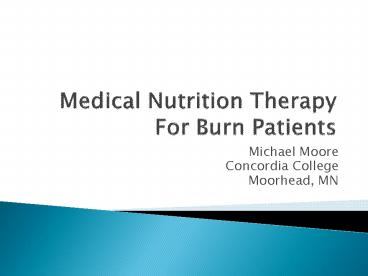Medical Nutrition Therapy For Burn Patients - PowerPoint PPT Presentation
1 / 19
Title:
Medical Nutrition Therapy For Burn Patients
Description:
Michael Moore Concordia College Moorhead, MN Able to recognize the types of burns Able to calculate energy and protein needs of burn patients Understand the body s ... – PowerPoint PPT presentation
Number of Views:817
Avg rating:3.0/5.0
Title: Medical Nutrition Therapy For Burn Patients
1
Medical Nutrition Therapy For Burn Patients
- Michael Moore
- Concordia College
- Moorhead, MN
2
Goals
- Able to recognize the types of burns
- Able to calculate energy and protein needs of
burn patients - Understand the bodys response to burns
- Understand the nutritional support for burn
patients
3
Defining Burns
- Bodily tissue injury resulting from exposure to
heat, chemicals, electricity, or radiation - Marked by varying degrees of skin destruction
http//www.merriam-webster.com/medlineplus/burns
4
Epidemiology
- More that 1.1 million victims per year
- 4,500 fatalities per year
- More than 50 of burn patients treated in
specialized burn centers
http//www.nih.gov/about/researchresultsforthepubl
ic/BurnsandTraumaticInjury.pdf
5
Classification of Burn Injuries
- There are two ways to classify burns
- Depth of the wound
- Percentage of the body surface area that is
affected
6
Classification of Burn Injuries
- There are four types of depths of the wounds
- Superficial burn (formerly first degree)
- Injury to epidermis
- Normally heals within 5-7 days (ex. sunburn)
- Appears red because of the increased flow of
blood - Heals without scarring
http//www.burn-recovery.org/injuries.htm
7
Classification of Burn Injuries
- 2. Partial thickness burn (formerly second
degree) - Involves destruction of the epidermis and dermis
- Produce open, weeping wounds
- Depending on size, may require skin grafts
- Usually leaves scars
http//www.burn-recovery.org/injuries.htm
8
Classification of Burn Injuries
- 3. Full thickness burn (formerly third degree)
- All three layers of skin are destroyed
- Includes loss of hair follicles, sweat glands and
the region where new skin cells are formed - Requires skin grafts
http//www.burn-recovery.org/injuries.htm
9
Classification of Burn Injuries
- 4. Fourth degree burns
- All layers of the skin is destroyed
- Burns extend through underlying tissues
- Involves destruction of muscle, organs, and bone
- Minimal pain
http//www.burn-recovery.org/injuries.htm
10
Four Types of Burns
- Thermal Burns
- Contact Burns- result from contact with hot items
or gasses - Example flames
- Scalds- result from contact with hot liquids
- Example spilled liquids, bathwater
- Most common
11
Four Types of Burns
- 2. Chemical Burns
- Causes
- Skin contact with chemicals
- Example acid or alkali, bleach
- Ingestion of chemicals
12
Four Types of Burns
- 3. Electrical Burns
- Causes
- Result from contact with an electrical energy
source - Example electrocution, lightning strike
- Severity correlated to amount of voltage
- May lead to cardiac arrest
13
Four Types of Burns
- 4. Radiation Burns
- Causes
- Result from contact with a source of radiation
such as ultraviolet rays - Example sunburn, use of tanning beds, high
exposure to x-rays - Can result in erythema
14
Estimating Size of Burns
- Rule of Nines
- System to estimate the percentage of total skin
that has been burned. - Arm- each 9
- Head- 9
- Leg- each 18
- Chest- 18
- Back- 18
- Neck- 1
- Perineum- 1
http//emedicine.medscape.com/article/1277360-over
view
15
Goals for Nutrition Support Include
- Maintain body mass
- Prevent specific nutrient deficiencies
- Improve wound healing
- Improve immunity
- Restore protein losses
- Avoid or minimize complications associated with
enteral and parenteral nutrition - Provide correct amount of nutrients and hydration
From Nutritional Balance is Disrupted...
16
Estimation of Energy Requirements - Adult
- Harris Benedict Equation
- Female BEE 655.1 9.6W 1.9H - 4.7A
- Male Bee 66.5 13.8W 5H 6.8A
- BEE X Activity Factor X Injury Factor
- W weight in kg
- H height in cm
- A age in years
- Activity Factor
- 1.2 confined to bed
- 1.3 ambulatory
- Injury Factor
- 2.1 2.5 with severe burns
17
Estimation of Energy Requirements Adult
- Ireton Jones Equation
- Spontaneously breathing (male or female)
- EEE (Estimated Energy Expenditure) 629 11(A)
25(W) 609(O) - Ventilated (male or female)
- EEE 1784 11(A) 5(W) 244(S) 239(T) 804
(B) - W Weight in kg
- A Age
- S Sex (male1, female2)
- T Trauma B Burns O Obesity (1 if present,
0 if not present)
18
Estimation of Energy Requirements - Child
- Galveston Formula
- Birth-4 yrs (2100 kcal x m2) (1000 kcal x m2
x TBSA/100) - 5-11 yrs (1800 kcal x m2) (1300 kcal x m2 x
TBSA/100) - 12-18 yrs (1500 kcal x m2) (1500 kcal x m2 x
TBSA/100)
19
Estimation of Energy Requirements
- Curreri Formula
- 24 kcal x kg usual body weight 40 kcal x TBSA
- Typical estimate for burn patients
- Adult 35-40 kcal/kg/day
- Child 40 (plus) kcal/kg/day































